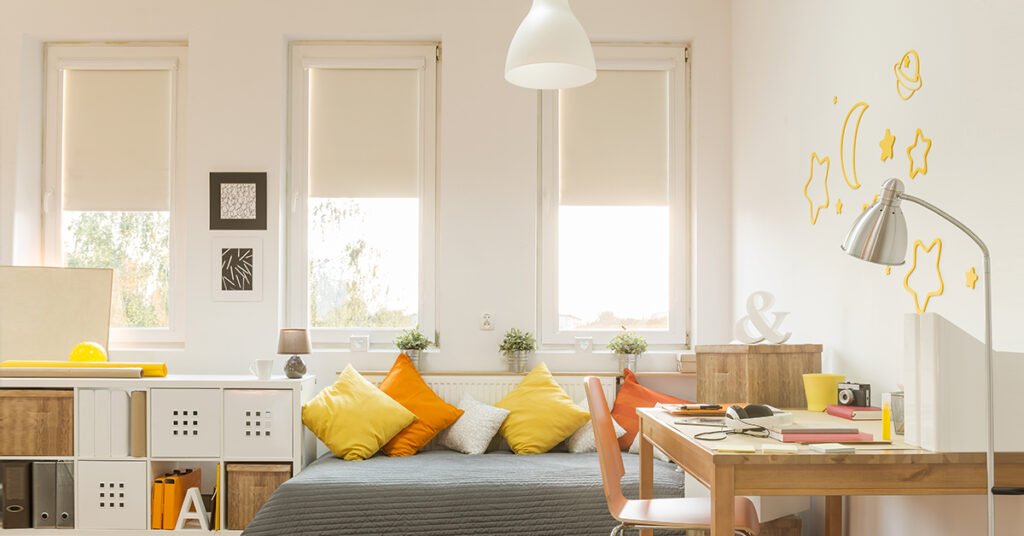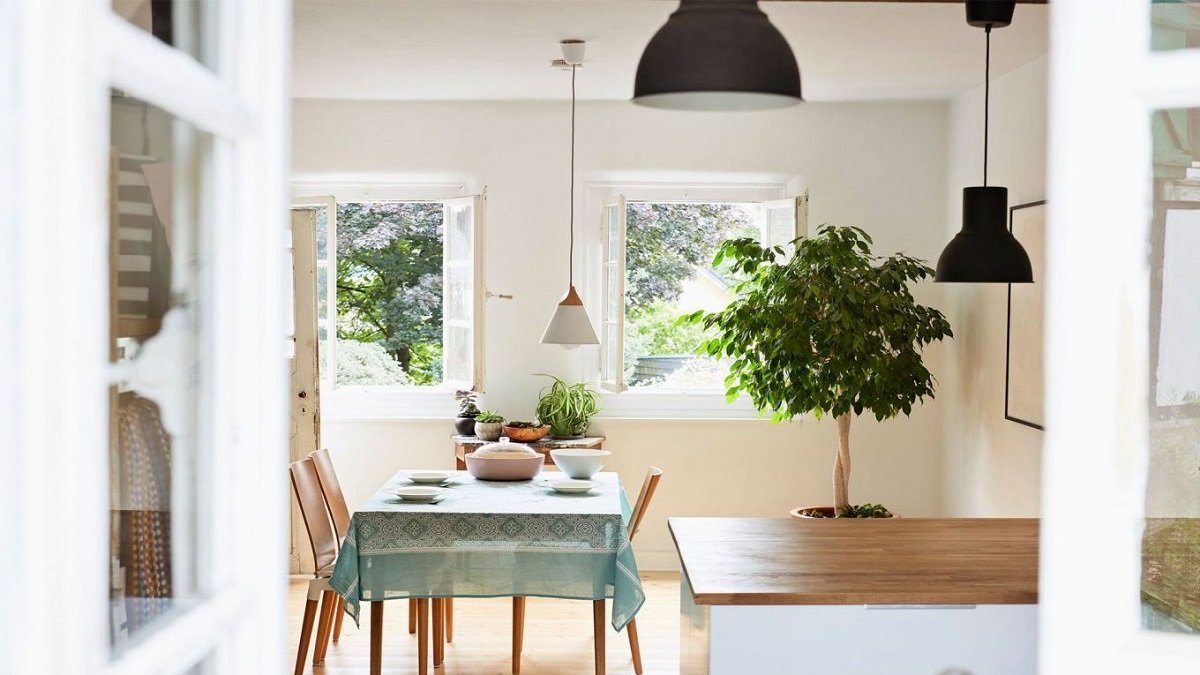As global temperatures rise and energy costs soar, finding natural ways to keep your house cool without relying on air conditioning has become not only a matter of comfort but also one of environmental and financial sustainability. While air conditioning is a quick and easy solution to combat heat, it often comes with high energy bills and environmental consequences due to its carbon footprint.
Fortunately, numerous natural methods can help maintain a comfortable indoor climate. By incorporating simple, eco-friendly strategies, you can effectively cool your house without relying heavily on energy-intensive systems.
This article explores natural methods to keep your home cool during hot weather, highlighting simple changes and long-term investments. From harnessing the power of natural ventilation to creating green spaces around your home, these methods can help maintain a cooler indoor environment, reduce your carbon footprint, and lower your utility bills.
Tips To Cool Your House Naturally

1. Utilize Natural Ventilation
One of the most efficient and natural ways to keep your house cool is through ventilation. By harnessing the movement of air, you can create a cooling effect that helps to reduce indoor temperatures. Natural ventilation allows fresh, cooler air to enter your home while pushing hot air out, creating a constant flow of air circulation.
Several types of natural ventilation systems can be implemented, including cross-ventilation, stack ventilation, and single-sided ventilation. Each of these systems relies on the strategic placement of openings, such as windows, doors, and vents, to encourage airflow.
Cross-Ventilation
Cross-ventilation involves creating an opening on opposite sides of the room, allowing a breeze to flow directly through the space. To maximize this effect, open windows or doors on opposite ends of the room or building. This allows cool air to enter through one side and push warm air out through the other.
Stack Ventilation
Stack ventilation uses the principle of warm air rising. In this system, warm air is vented out through the upper parts of a room, while cooler air enters from lower levels, creating a natural convection cycle. This method works particularly well in multi-story homes where hot air can easily rise and be released through high-level windows or vents.
Single-Sided Ventilation
This method involves having openings on one side of the building to allow air to enter, creating a one-way airflow through the home. While not as efficient as cross or stack ventilation, single-sided ventilation can still promote air movement and help cool down your living space when paired with other strategies.
By strategically opening windows in the early morning or late evening, when outdoor temperatures are lower, you can maximize the cooling effect. In regions with cooler nighttime temperatures, opening windows at night and closing them during the heat of the day can significantly reduce the need for air conditioning.
2. Install Reflective Window Treatments
Windows are a primary entry point for heat, as sunlight streaming through glass can dramatically increase indoor temperatures. However, you can mitigate this effect by installing reflective window treatments that reduce heat gain and block UV rays. These window treatments come in various forms, including reflective films, shades, blinds, and curtains, and can help keep your home cooler without obstructing natural light.
Reflective Window Films
Reflective window films are thin, heat-reflective coatings that are applied directly to the surface of your windows. These films are designed to reflect the sun’s rays and reduce the amount of heat entering the home. By reflecting infrared light, which is responsible for much of the heat gain, reflective window films can keep indoor spaces significantly cooler, especially during the hottest parts of the day.
Shades and Blinds
Installing shades or blinds can also help control the amount of heat entering your home. For maximum cooling, opt for materials that have insulating properties, such as cellular shades or thermal blinds. These products create a further layer of protection against heat and can block direct sunlight without compromising your view.
Thermal Curtains
Thermal or insulated curtains can help keep the sun’s heat from penetrating your home. These curtains are made with special heat-reflective materials that help prevent the transfer of heat and cold. By keeping your windows covered during the hottest parts of the day, you can reduce the amount of heat entering your home and help maintain a more comfortable indoor temperature. It is one of the best natural ways to keep your house cool.
3. Grow Shade Trees and Vines Around Your Home
Strategic landscaping plays a crucial role in answering how to keep your house cool. One of the most effective ways to reduce heat gain is by planting shade trees and climbing vines around your home. These natural elements can protect you from the sun’s rays and significantly lower the temperature around your house.
Planting Shade Trees
Trees, particularly deciduous trees, are excellent for providing shade in the summer months. Deciduous trees lose their leaves in the winter, allowing sunlight to penetrate and warm your home when it’s most needed. During the summer, the dense foliage blocks direct sunlight, keeping the interior cooler. Common trees for shade include oak, maple, and birch. Planting these trees near windows, especially on the west or south side of your home, can provide significant cooling benefits.
Vines on Trellises
Vines can also be an effective way to shield your home from the sun. By growing climbing plants like ivy, wisteria, or grapevines on trellises, you can create shaded areas that reduce heat absorption. Vines can be trained to grow on walls, patios, and even pergolas, providing natural shade that helps maintain a cool indoor environment.
Additionally, vines can act as natural air conditioners by reducing the amount of heat that radiates into the house. Green walls, or living walls, are becoming increasingly popular as an energy-efficient way to insulate homes and keep them cool.
4. Use Roof Insulation
The roof of your home is a major source of heat gain, especially if it is not properly insulated. Without sufficient insulation, heat from the sun can penetrate your home, causing indoor temperatures to rise. Installing proper roof insulation helps to block out heat and keep your home cooler during the summer months.
Types of Roof Insulation
There are several options for insulating your roof, each with its benefits. Some of the most popular options include:
- Reflective Coatings: These are applied directly to the roof and reflect sunlight away, preventing heat from entering your home. Reflective coatings are particularly useful for homes with dark roofs, as dark colors tend to absorb more heat.
- Foam Insulation: Foam insulation, such as spray foam, helps to create an airtight seal that prevents warm air from entering through the roof. It’s an effective method for improving energy efficiency and reducing the need for cooling.
- Fiberglass Insulation: Fiberglass is a traditional option for roof insulation, providing an effective barrier against heat. It works by trapping air pockets that resist heat transfer.
By properly insulating your roof, you can reduce the amount of heat entering your home, lower your cooling costs, and improve overall comfort. That’s one of the natural ways to keep your house cool.
5. Cool Your House with Indoor Plants
Indoor plants do more than just add a touch of greenery—they can also help keep your home cool. Plants play a role in natural ways to keep your house cool through the process of transpiration, in which they release moisture into the air. This process helps increase humidity and has a natural cooling effect.
Best Indoor Plants for Cooling
Certain indoor plants are particularly effective at cooling the air:
- Snake Plant (Sansevieria): This hardy plant is known for its air-purifying properties, but it also helps cool the air by releasing moisture during the night.
- Bamboo Palm (Chamaedorea seifrizii): The bamboo palm is an excellent choice for humidifying the air and providing natural cooling in warmer climates.
- Aloe Vera: Known for its healing properties, aloe vera also helps reduce heat by releasing moisture.
By placing several plants around your home, you can increase humidity, reduce temperature fluctuations, and create a cooler indoor environment.
6. Install a Green Roof or Roof Garden
A green roof, or rooftop garden, is an eco-friendly and effective solution for keeping your home cool. Green roofs are covered with vegetation, which helps to insulate the home and reduce the heat absorbed by the building. The soil and plants on a green roof absorb sunlight and provide shade, which helps cool the building below.
How Green Roofs Work
Green roofs work by providing a natural barrier that absorbs heat. The plants on the roof act as a form of insulation, reducing the amount of heat that penetrates the building. The process of evapotranspiration, where plants release moisture into the air, also has a cooling effect. Additionally, green roofs help to reduce the urban heat island effect, where cities experience higher temperatures due to the abundance of concrete and asphalt.
Designing a Green Roof
When designing a green roof, it’s essential to consider factors like soil depth, plant types, and waterproofing. For optimal cooling, choose drought-resistant plants like succulents, grasses, and herbs that require minimal maintenance. Green roofs are particularly effective in urban areas, where they can help reduce the surrounding temperature and improve air quality. It is one of the effective and natural ways to keep your house cool.
7. Optimize the Use of Natural Cooling Materials
Certain natural building materials can help keep your home cool by preventing heat absorption. These materials work by either reflecting heat, absorbing moisture, or allowing air to circulate more efficiently.
Clay and Adobe
Traditional materials like clay and adobe are excellent at absorbing heat during the day and releasing it at night, helping to answer how to keep your house cool. These materials are particularly effective in hot climates.
Bamboo and Stone
Bamboo is a natural insulator, while stone walls provide excellent thermal mass, keeping the interior cool by absorbing heat and slowly releasing it at night. By incorporating these natural materials into your home’s design, you can reduce heat absorption and keep your living spaces cooler.
8. Create Cross-Breeze with Strategic Furniture Arrangement
Once you’ve set up natural ventilation, the next step is to optimize the flow of air within your home. One of the simplest ways to improve airflow is by strategically arranging furniture.
Maximizing Cross-Ventilation
Make sure not to block windows or vents with large pieces of furniture. Create clear paths for air to flow from one side of the room to the other, allowing natural breezes to circulate. Consider positioning your furniture to complement the direction of prevailing winds and maximize airflow. That’s one of the vital and natural ways to keep your house cool.
9. Use Natural Cooling Systems
In addition to the strategies mentioned above, you can also use more traditional, passive cooling systems to keep your home cool without relying on air conditioning. Some systems, such as earth tubes and evaporative coolers, use natural processes to cool the air.
Evaporative Coolers (Swamp Coolers)
Evaporative coolers use water to cool the air through evaporation. These systems work best in dry climates, where the air has low humidity. By passing warm air over water-saturated pads, the air is cooled before being blown into the home. Evaporative coolers are energy-efficient and environmentally friendly.
Earth Tubes
Earth tubes, also known as geothermal ventilation systems, use underground pipes to draw cool air from below the surface. As the air travels through the pipes, it is naturally cooled by the earth’s temperature. This cool air is then directed into the home, providing a consistent, natural source of cool air.
Why You Should Try To Cool Your Home Naturally
With rising energy costs and growing environmental concerns, more of you are looking for natural ways to keep your house cool. Relying less on air conditioning not only reduces your carbon footprint but also provides several other benefits, including cost savings and better indoor air quality.
One of the main advantages of cooling your home naturally is the reduction in energy consumption. Air conditioning units can consume a lot of electricity, which contributes to higher utility bills. By utilizing natural methods like opening windows for cross-ventilation, using ceiling fans, or shading windows with blinds or curtains, you can keep your home cool without relying on energy-intensive systems.
Additionally, cooling your home naturally helps lower your carbon footprint. Air conditioners release refrigerants into the atmosphere, contributing to global warming. By choosing eco-friendly cooling solutions, you’re helping reduce greenhouse gas emissions, contributing to a healthier planet.
Natural cooling methods also promote better indoor air quality. Air conditioners can sometimes circulate allergens and dust, which may aggravate respiratory problems. On the other hand, natural ventilation allows fresh air to flow into your home, improving air circulation and making the environment more breathable.
Moreover, cooling your home naturally often leads to a more comfortable living space. It encourages a connection to the outdoors, as natural airflow and sunlight can create a pleasant ambiance. Simple practices like planting trees outside windows for shade or using reflective roofing materials can significantly reduce the need for mechanical cooling.
In conclusion, cooling your home naturally is not only good for your wallet but also for the planet. It’s a sustainable, healthier, and more energy-efficient way to stay comfortable during the warmer months.
FAQ
Q: How can a house be kept safe from heat?
A: Installing window coverings like blinds or curtains to prevent sunlight, utilizing light-colored roofs, and insulating walls, ceilings, and flooring are some ways to shield your house from heat. Additionally, make sure there is enough ventilation, caulk the spaces around doors and windows, and think about installing an attic fan.
Q: Is it possible to utilize water to chill your home?
A: If you want to save power or don’t have air conditioning, you may use water to chill a space. A “swamp cooler” is a common term for this technique, which involves evaporation.
Q: Natural cooling: what is it?
A: Utilizing the site’s natural resources as heat sinks—that is, anything that absorbs or distributes heat—is just as important to natural cooling as the building’s architectural layout. The earth/soil, the external air (wind), and the higher atmosphere (night sky) are examples of on-site heat sinks.











